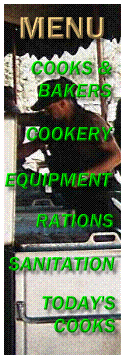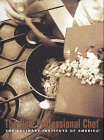
David Castle's Army Kitchen Truck
Serving Food in the Field
Excerpted from the 1944 edition of Mess Management and Training (TM 10-205)
[Menu] [Plan for feeding] [Preparation]
Feeding troops in combat has always been tough. Since commanders recognize that good morale comes with serving hot chow to troops in the combat zone, aggressive commanders instructed their cooks to bring one or two hot meals forward each day, often under the cover of darkness. These commanders knew what happened to morale when their troops subsisted on C-rations for weeks on end.
Lt. Col. Coy W. Baldwin wrote in the May-June 1953 of the Quartermaster Review: "Still more surprising is that old campaigners learn to realize the truth of a saying that has become axiomatic in Korea -- 'the farther forward, the better the food.'" By the time Korea and Vietnam rolled around, the Army and the Marines had perfected the art of feeding hot meals to combat troops.
When operating in the field, the messing unit is faced with a different situation from that of a unit in the garrison. When supplies arrive, the mess sergeant can inventory them to see what is on hand, and break them up into as practical a menu as circumstances permit.
The menu must be designed to suit the mess kit and the conditions under which the troops will be fed. Since the commissioned officer personnel will be occupied with many other problems, the mess sergeant must bear the chief responsibility in almost all matters concerning the feeding of the troops of the unit.
The regimental supply officer determines the best plan for feeding his regiment. He must consider the method of distribution prescribed by the division or higher authority, the ration cycle, the tactical situation, the terrain, the weather, the availability of trucks and routes, and the traffic conditions in general.
When his plan has been approved by the regimental commander, it is made known to the battalion supply officers and the commanders of companies and other attachments not parts of battalions. The details of the plan are sent to the company commanders as early as practicable so that they can give the necessary instructions to the mess personnel of the different companies in time
In the absence of other instructions each company will be responsible for drawing its rations at the regimental supply point and for solving its own problems as to where the meal will be prepared and how the company troops will be fed.
The feeding plan includes any of the following instructions that might be appropriate:
-
The location of the kitchen bivouac(s) (usually in the regimental-train bivouac).
-
The place where each meal will be prepared (in the regimental-train bivouac, in the advanced regimental or battalion kitchen areas, or in company mess location).
-
The number of kitchen and baggage vehicles per battalion to be used to deliver food to troops (usually one truck per company -- two per battalion when necessary to conserve transportation or keep down traffic).
-
Any additional items of supply to be sent forward to troops.
-
The time kitchen trucks will leave the bivouac to deliver meals to troops.
-
Any restrictions upon movement.
Mess sergeant should be notified when the supplies are ready for distribution. Company supplies are turned over at the regimental distribution point to details from company mess groups, who carry them to their kitchens. If the kitchen locations are beyond hand-carrying distance from the distribution point, one or more kitchen trucks of a battalion are used for delivery.
When the rations are received at the company kitchens, they are divided into three meals, and the menu and recipes to be used are worked out. Each company's mess detail prepares the meals on its field ranges:
-
At the kitchen locations in the regimental-train bivouac,
-
At battalion kitchen bivouacs located nearer the troops than the regimental-train bivouac,
-
At some forward location near the company, or
-
In the kitchen truck either while in movement or at a halt.
It will seldom be feasible to advance the kitchens to the locations of units which are dispersed for combat. During combat, meals are usually prepared at a rear kitchen location. This is usually in the regimental-train bivouac, but sometimes in the battalion kitchen bivouac.
When possible, cooked food should be sent forward under cover of darkness. Plans should provide for timing the preparations of supper so that the trucks carrying it to the troops leave the field-train bivouac just after dark, and for timing breakfast so that trucks can return before daylight.
The fundamentals of cooking are the same in field as in garrison. The chief difference is in the equipment used. Since Field Range M-1937, a gasoline burning range can be operated with wood if necessary, the cook should be trained in the handling of both types of fuel. The menu must be adjusted to the type of range in use. Part of the meal should be prepared on the top of the range and part in the oven. This is especially true when either Field Range No. 1 or No. 2 is used. Dishes that require long preparation should be avoided when cooking time is limited.
Necessary camouflage measures must be taken to protect kitchen installations from observation both from the air and the ground. Since most cooking must be done at night, care must be taken to limit the glare from stoves. Refuse, such as tin cans and litter from field rations, should be buried. Utensils that might reflect light must not be allowed to lie exposed.
David Castle's Restored Army Kitchen Truck
Bibliography
War Dept. Mess Management and Training. TM 10-205. Washington: GPO, October 3, 1944. 84pp. This information is taken from pages 34-6.
May 2000
| Bulletin Board | Keyword Search |
| Bookstore | Links |
| About Us | Recent Additions |

